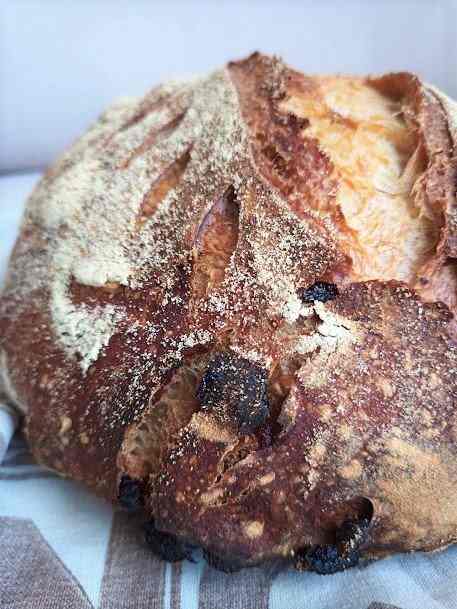How to Add Cinnamon Raisin Inclusions to Sourdough Bread
Lemonkerdz was once a baker by profession. Now she enjoys baking at home for family and friends.
Sourdough Bread With Fruit Inclusions
This recipe follows the same ingredients and method as our artisan sourdough bread. The recipe differs on how to add your inclusions so that you get an even distribution throughout your loaf.
Instead of raisins you may want to add your choice of inclusions. You can use the same method that I will show you below.
Alternatives to Raisins
- Olives
- Cranberries
- Dates and walnuts
- Mix of dried fruits
- Golden raisins, walnuts, cinnamon and orange zest
Ingredients
- Sourdough leaven (see recipe link below)
- 500 grams all-purpose flour
- 10 grams salt
- 250 grams tepid water
- 150 grams raisins roughly chopped, soaked in a little water overnight
- 2 teaspoons cinnamon
- Artisan Sourdough Bread Recipe
This is my sourdough starter recipe. Learn how to make the starter and the leaven.
Instructions: How to Add Inclusions to Your Dough
- In a large bowl, add your sourdough leaven (sponge) that you made the night before (see recipe link above to learn how to make the starter and the leaven). Add the tepid water to the sourdough leaven and stir well to combine to a milky looking water mix with no lumps. Leave for 15 minutes to rest.
- Add the flour to the water mix containing your leaven and mix well with a stand mixer or by hand just using your fingers to combine together until you have a smooth soft dough. Do not worry too much if it appears wet, the flour will hydrate drying up the mix.
- Leave to rest for 30 minutes covered with a cloth or plastic wrap. This is called autolysis (see note on autolysis, below).
- Add the salt and cinnamon and mix in well (use your stand mixer or hand knead). Leave to rest for around 40 minutes and then mix again. I recommend the lift and stretch method by hand (see note below on lift and stretch). Repeat this step for the next 2 hours.
- (Note: For this step, see video below on "fold inclusions" for more help.) Turn your dough out into a rectangular container about 25 cm x 35 cm and stretch it out flat but careful not to burst all the air bubbles you have created. Squeeze out the liquid from your raisins and spread them over the dough and press them into the dough with your fingertips. Lift and fold over the dough to halfway. From the other end, lift and fold over the dough to the end. You should now not see any visible raisins. Lift and turn your dough 1/4 turn and stretch out flat to fill the container, leave to rest for around 30 minutes. Repeat the same fold as above. Lift and fold over the dough to halfway then from the other end lift and fold the dough to the end.
- Shape your bread: Place upside-down in a floured banneton proofing basket. (Most of us don't have a banneton when we are starting out; I don't own one yet either. Simply line a bowl with a floured tea towel and put a banneton on your wish list.) Place in the refrigerator overnight for a slow fermentation.
- Preheat your oven on high 280 degress C. It’s a great idea to preheat your Dutch oven or Crock-Pot on the middle shelf too; this helps the bread base crisp up better. When heated, carefully remove the Dutch oven, place a liner inside it to stop the dough sticking to the base and lightly sprinkle flour or corn meal on the liner. Turn out your proved dough into the Dutch oven. At this point, if you are feeling brave, score the dough with your own personalized design. Because the dough is cold it makes it easier to score. With a bread razor (another wish list item) or sharp knife score about 3mm deep. Spray the top of the dough with water and dust with cornmeal. Cover with the lid and bake for 40 minutes on high heat then remove the lid and bake for a further 15 minutes or until desired coloured crust is achieved. (Remember: Each oven is different so you may have to adjust cook time accordingly.)
Folding Inclusions
Note: Autolysis
Autolysis is a process in bread making which involves mixing flour and water together for a period of time, before adding other ingredients. This hydrates the flour, which encourages enzymes to begin gluten development. Dough can be left to autolyse from 10 minutes to 5 hours or more.
Note: Lift and Stretch Method
This method stops you bursting all those nice air bubbles you want in your sourdough. Wet your fingers on one hand and slide your hand down the side of the dough then with your fingers lift the dough and fold over the top to the opposite side. Repeat this action on each of the four sides of your dough. Each time you repeat this action you will notice the dough will stretch further without tearing.
Another Sourdough Recipe
- Sourdough Waffle Recipe That Uses Sourdough Starter Discard
Have you ever wondered if you can use discarded sourdough starter? The answer is yes! Try these sourdough waffles and you'll never throw away sourdough starter again. The waffles are easy to make and your family will love them—and you—forever.

























